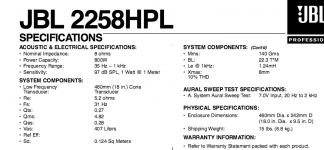"Patrick",The prosound company "Clair Brothers" has some neodymium JBL woofers for sale on eBay right now. They're neat, huge displacement with the distortion reducing differential driver motor.
My eighteen will be here on Wednesday.
The 2258 HPL displacement (only 8mm Xmax) has not been considered "huge" this century.
Attachments
A pair of Dayton 295-120 cost less and may be run PPSL.
http://s959.photobucket.com/user/fu...ullsubquad12_zpsb771020a.jpg.html?sort=3&o=17
http://s959.photobucket.com/user/fu...ullsubquad12_zpsb771020a.jpg.html?sort=3&o=17
DJK,A pair of Dayton 295-120 cost less and may be run PPSL.
The pair of 295-120 offer more displacement for less $$ than the used JBL 2258 HPL, but don't have an orange badge and have not been "broken in" for ten years ;^) .
Art
DJK,
The pair of 295-120 offer more displacement for less $$ than the used JBL 2258 HPL, but don't have an orange badge and have not been "broken in" for ten years ;^) .
Art
The 295-120 offers about 10% less displacement.
The big advantage of the JBL over the Dayton is the motor; that massive heatsink will allow it to play louder with less power compression. And the differential drive motor flattens the BL curve, which ALSO allows output that's consistent whether loud or quiet.
Plus, for my application, low weight was a big part of the criteria. Ferrite fifteens are freaken heavy, as my Gedlee Summas demonstrated.
But I *do* agree with you guys, the differences here aren't huge. Which is why I'm modeling an enclosure with a Alpine SWS-15D2. That might be a nice compromise between the huge box and high tech motor of the JBL, versus the low-tech and affordable Dayton.
The 295-120 offers about 10% less displacement.
The big advantage of the JBL over the Dayton is the motor; that massive heatsink will allow it to play louder with less power compression.
Power compression on those Daytons is pretty substantial. I reckon 6dB or more at AES like all the other Eminence drivers of similar flavor. I ran a pair of them on 400 watts (bridged Lanzar 251) for many years, and could get them "smelling like fresh oranges" routinely. It never hurt anything, but it noticeably reduced the output. Once they started to smell, they wouldn't bottom out anymore. Not enough voltage. I replaced them with a pair of LAB12's and 2.5X the power and no more smell - even at mind boggling SPL in the cab of the truck. And LAB12's aren't exactly the last word in cooling technology anymore. The JBL is probably better still.
I've often wondered about attaching heat sinks to woofers in front loaded horns and venting to the outside of the box. Usually the clearance to the back of the magnet is relatively small - making the fins stick out wouldn't be too far fetched. I have lots ofbig flat-on-one side heatsinks - more than I'll ever use up building amps. The challenge would be making the assembly rigid and air tight.
The 295-120 offers about 10% less displacement.
The big advantage of the JBL over the Dayton is the motor; that massive heatsink will allow it to play louder with less power compression. And the differential drive motor flattens the BL curve, which ALSO allows output that's consistent whether loud or quiet.
Plus, for my application, low weight was a big part of the criteria. Ferrite fifteens are freaken heavy, as my Gedlee Summas demonstrated.
But I *do* agree with you guys, the differences here aren't huge. Which is why I'm modeling an enclosure with a Alpine SWS-15D2. That might be a nice compromise between the huge box and high tech motor of the JBL, versus the low-tech and affordable Dayton.
Art convinced me to use the JBL for something else. My build is here:
Maximum Bass for $1000 - Page 2 - Subwoofers / Enclosures - SMD Forum
I did a breakdown on how to build one of those CX800 boxes here: DIY PK Sound Sub for your Car - Car Audio | DiyMobileAudio.com | Car Stereo Forum
A lot of the data is already in this thread, but the post above is a little bit more coherent. It also delves into the challenges presented at these power levels, basically you really want a driver with a very low impedance.
A lot of the data is already in this thread, but the post above is a little bit more coherent. It also delves into the challenges presented at these power levels, basically you really want a driver with a very low impedance.
I did a breakdown on how to build one of those CX800 boxes here: DIY PK Sound Sub for your Car - Car Audio | DiyMobileAudio.com | Car Stereo Forum
A lot of the data is already in this thread, but the post above is a little bit more coherent. It also delves into the challenges presented at these power levels, basically you really want a driver with a very low impedance.
Thanks for the link and all the work you put into your posts. I don't have a diymobileaudio account, so I'll post a reply here. One possibility is to use two car amps that are linked or strapped. It's not a cheap way to go, but it's a good way to put out the most power for a 2 ohm load.
Regards,
Matt
- Status
- This old topic is closed. If you want to reopen this topic, contact a moderator using the "Report Post" button.
- Home
- Loudspeakers
- Subwoofers
- PK Sound CX800: 95% efficient??
